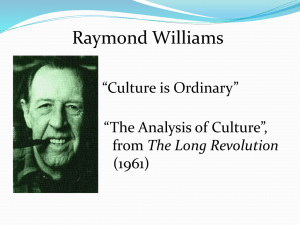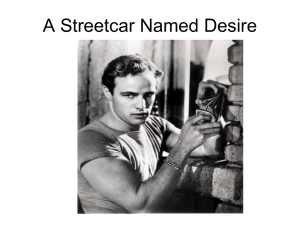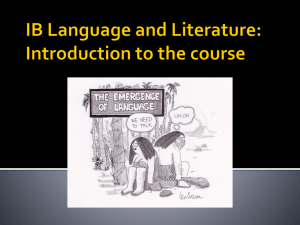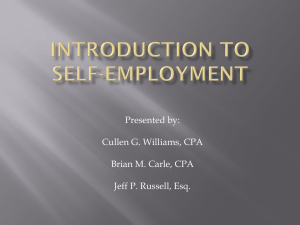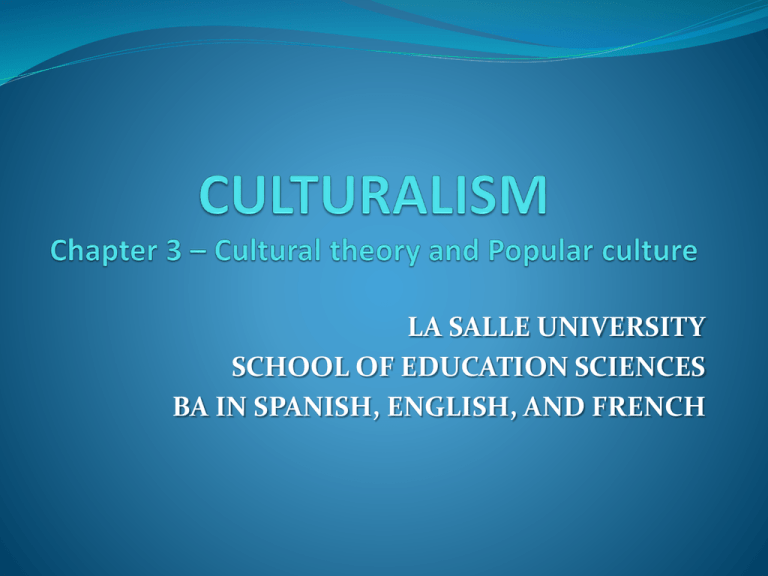
LA SALLE UNIVERSITY
SCHOOL OF EDUCATION SCIENCES
BA IN SPANISH, ENGLISH, AND FRENCH
INTRODUCTION
The term ‘culturalism’ was coined to describe Thompson's work, and the work of Hoggart
and Williams, by one of the former directors of the Centre for Contemporary Cultural
Studies, Richard Johnson (1979).
Johnson uses the term to indicate the presence of a body of theoretical concerns
connecting the work of the three theorists. Each, in his different way, breaks with key
aspects of the tradition he inherits. Hoggart and Williams break with Leavisism;
Thompson breaks with mechanistic and economistic versions of Marxism.
What unites them is an approach which insists that by analysing the culture of a
society – the textual forms and documented practices of a culture – it is possible
to reconstitute the patterned behaviour and constellations of ideas shared by the
men and women who produce and consume the texts and practices of that
society. It is a perspective that stresses ‘human agency’, the active production of
culture, rather than its passive consumption.
Richard Hoggart: The Uses of Literacy
The uses of literacy is divided in two parts:
- The older order (30’s): Working class culture.
- The new order (50’s): Mass culture.
Threat from new forms of mass entertainment together with decline in moral
seriousness.
Working class’ ability to resist manipulations of mass culture.
30’s – The rich full life = A strong sense of community / Self-made entertainment /
Working class’ appreciation of popular songs.
50’s – A candy-floss world = Everything is now far too thin and insipid /
Manipulative power of the culture industries (Commercial culture) evident by the
success of the radio and soap operas / The jube-box (A sign of obediently receptive
passivity)
Good past / bad past binary opposition
Raymond Williams: ‘The analysis of culture’
For Williams, culture expresses meanings and values (structure of feeling) and through
cultural analysis it is possible to clarify them.
Cultural analysis is a method for understanding what a culture is expressing by analyzing its
-
cultural expressions and therefore reconstructing and interpreting a particular way of life.
There are 3 types:
Culture ideal = discovery and description.
Documentary = critical assessment.
Social = Clarification of meanings and values.
Cultural analyses want a common culture not a hierarchical culture / Distinction between
commodities available by culture industries and what people make of them.
He talks about 3 levels of culture:
Lived culture: Experienced by people in their day-to-day life in a specific place and at a
particular time / Access through the documentary record of the culture.
Period culture: It is the recorded culture which includes products and daily facts from a
culture.
Culture of the selective tradition: It is the one that connects the previous types of culture.
Many factors such us interests and values of the dominant class influenced the selection of the
texts chosen for understanding the lived culture.
E.P. Thompson: The Making of the English Working Class
The making of the English working class is a historical phenomenon. It is not a
structure or a category, but a historical relationship of unity and difference.
Working class is a result of common experiences (inherited or shared) based on
people’s identity and interests. Those experiences mean culture.
The making of the English working class was related to three different perspectives:
1. Political and cultural transitions from the 18th century: religious dissent, popular
discontent, and influence of the French revolution.
2. Social and cultural experience of the industrial revolution: artisans, cotton
spinners and weavers.
3. Growth of working class consciousness.
The making of the English working class is an example of “history from below”.
This history is the experience of men that make their own history based on
circumstances from the past. Working class as conscious agents of their own
making.
Stuart Hall and Paddy Whannel: The Popular Arts
Hall and Whannel developed an approach for handling problems of value and
evaluation in the study of POPULAR CULTURE.
POPULAR CULTURE
Their first concern was to replace the misleading generalizations that facilitate
popular discrimination. Rejecting Leavisism’s arguments that high culture is good
and all popular culture is bad.
They reject two common teaching strategies when the popular culture is intr in the
classroom.
a. Defensive Strategy: When, the popular culture is condemn it as a second-rate
culture.
b. Opportunity Strategy: When, the popular tastes of students are embraces to lead
them to better things.
They help people become a more demanding audience. We must judge texts and
practices on their own terms / Not a question of superiority or inferiority but a
question of different kinds of satisfaction.
Stuart Hall and Paddy Whannel: The Popular Arts
POPULAR ART
Art which operates within the confines of the popular. A popular art for the people.
Good popular culture is able to re-establish the relationship between performer and
audience. It re-states values and attitudes already known. It has in common with
folk art, but it is individualized art.
Mass art is a corrupt version of popular art. / Formulaic, escapist, aesthetically
worthless, unrewarding.
YOUTH CULTURE:
Pop music culture establishes a sense of identity among youth.
They identify with those collective representations and use them as guiding
fictions, which compose their mental picture of the world.
But, it is a contradictory mixture of the authentic and manufactured. It is self-
expression for the young and pasture for commercial providers.
The Centre for Contemporary Cultural Studies
Hoggart established the Centre for Contemporary Cultural Studies at the
University of Birmingham.
Culturalists study cultural texts and practices in order to reconstitute or
reconstruct the experiences, values, etc. – the ‘structure of feeling’ of particular
groups or classes or whole societies, in order to better understand the lives of
those who lived the culture.
Williams’s social definition of culture, Thompson’s act of historical rescue, Hall
and Whannel’s ‘democratic’ extension of Leavisism argue that popular culture
(defined as the lived culture of ordinary men and women) is worth studying. It
is on the basis of these and other assumptions of culturalism, channelled
through the traditions of English, sociology and history, that British cultural
studies began.
Bibliography
Storey, John (2009). Cultural Theory and Popular Culture. An Introduction (5th
edition). London: Pearson-Longman.
www.pearsoned.co.uk/storey


